Comments/Ratings for a Single Item
And now, a question that's been nagging on me for a while: Which should be the eighth (and final) weapon piece in my Clue Chess game?
So far I have seven weapons selected: the six from the classic game, and one that's appeared in the most variant versions:
- Candlestick (mK2cafmK)
- Dagger (mK2mafcabK)
- Lead Pipe (KcabK)
- Poison (mnNcW)
- Revolver (mWcaibCcaibZ)
- Rope (KcaibaK)
- Wrench (nNcafsmK)
(A secondary question: do these seven all seem reasonably close in power? I'll provide some extra information in a separate reply, in case it's needed.)
The candidates for the eight weapon are:
- Axe (WcN)
- Baseball Bat (m(afal)3Fn(aln)3AmWcabNXXcabAXY)
- Dumbbell (mW[dD-bucW][cD-ubcW])
- Horseshoe (nN[nN-fcaibW][nN-lcaibW])
- Trophy (KS)
I'm still rather unsure about how well I've done the Dumbbell's move, so right now it's my least favorite. I am, in fact, leaning most toward the Axe at this point, though I'll gladly take other ideas.
While I mostly want to rely on game balance (keeping the eight weapon pieces close to equal in power level), other considerations can include appearances in variants, ease of understanding, overlaps with other weapon pieces, general aesthetics, or anything else you like.
Extra information about Clue Chess that may or may not be relevant:
- The board is 25x25, with special spaces for the Rooms and blacked-out spaces around the players' starting areas (except in front).
- Similar to regular Clue(do), there can be anywhere from 2 to 8 players.
- There will be only one of each weapon; they start neutral, in starting places on the board.
- When a player captures a weapon piece, that player's King gains the abiltiies of that piece.
- There will be no limit on how many weapons the King can carry (as of this moment, anyway).
- I haven't fully decided yet what happens to the weapons when the King is captured. The King itself is returned to its starting square, and I'm inclined to do the same with the weapons, though I may decide on something else.
- It may or may not be allowed to move the weapons as independent, "neutral" pieces. If it is, it'll be move-without-capture only.
Feedback on these rules wouldn't be entirely unwelcome, though for now I want to focus on selecting the eighth weapon.
anybody reads this? can use it if u want… but I recommend to rename and put in another game
If that's in reference to your Bullet, I've been thinking about that. Like today's Yey, it'd be an interesting Pawn or Superpawn type piece.
For an eighth weapon, have you considered a blowgun?
Since it's never appeared in any published version of Clue, no, I haven't.
276. Grand Vizier. This is yet another intereseting piece from Robert Shimmin's game Scheherazade. It can step to any adjacent space, or leap (1,3) or (2,2). (KAC)

I rather like this piece for slightly-large boards such as the 12x12 one shown here.

This is yet another model that I made after studying historical pictures. I may need to accentuate the sash more, but on the whole I think it came out OK.
Tinkercad continues to have its upload problems, so it took until today to get the weekend's pair.
277. Faro. and 278. Loco. Also called the Argentinian Rook and Argentinian Bishop, these two pieces (along with the corresponding Knight and Queen -- Saltador and Señora, respectively) were invented in 2016 by Manfred Rittirsch for use in fairy chess problems; they've rarely been seen in an actual game until this year.
Argentinian pieces capture with a normal move, but must pass a hurdle in order to move without capturing. The distance before and after the hurdle can be anything, as long as the piece follow a straight line and jump exactly one hurdle.
As suggested by their alternate names, the Faro moves orthogonally (cRmpR), while the Loco moves diagonally (cBmpB).
The names, translated from Spanish, mean lighthouse and crazy person.
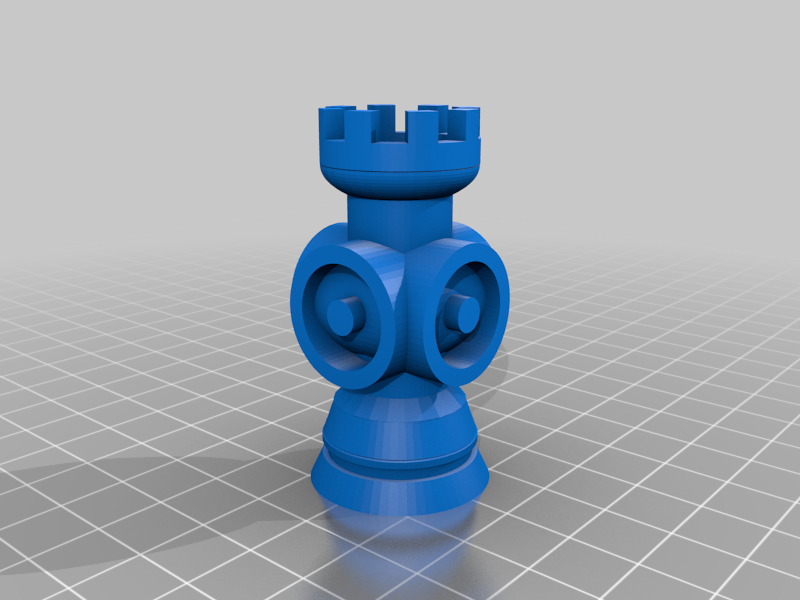
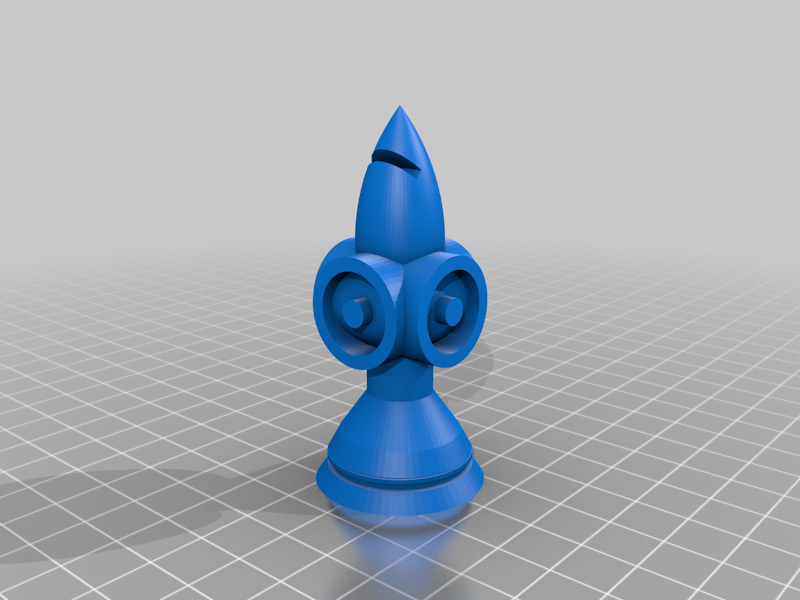
The added-on part of the dot inside a circle is intended to represent the Cockade of Argentina, one of the country's most recognizable national symbols.* My apologies to those in North America (and elsewhere) who associate that image with the Target department store chain.
(I'm thinking that maybe I should rework these pieces, with the circles a smaller diameter.)
The Señora, of course, compounds these two. (The Saltador moves like a normal Knight, but must have a piece in one of the two intervening spaces to move without capturing.) More Argentinian pieces could be extrapolated from all these, including Archbishop, Chancellor, Nightrider, and others.
*The most recognizable is the Sun of May, which consists of a sun with a face and 32 rays extended, alternating between straight and undulated, as seen in the center of the country's flag. While a beautiful and singular icon, it's a bit too complex for this context.
And in case anyone's interested, I have the lineup figured out for Clue Chess. Some of these pictures need a bit of reworking, I'll admit, but in general this is what you'll see on the character cards:
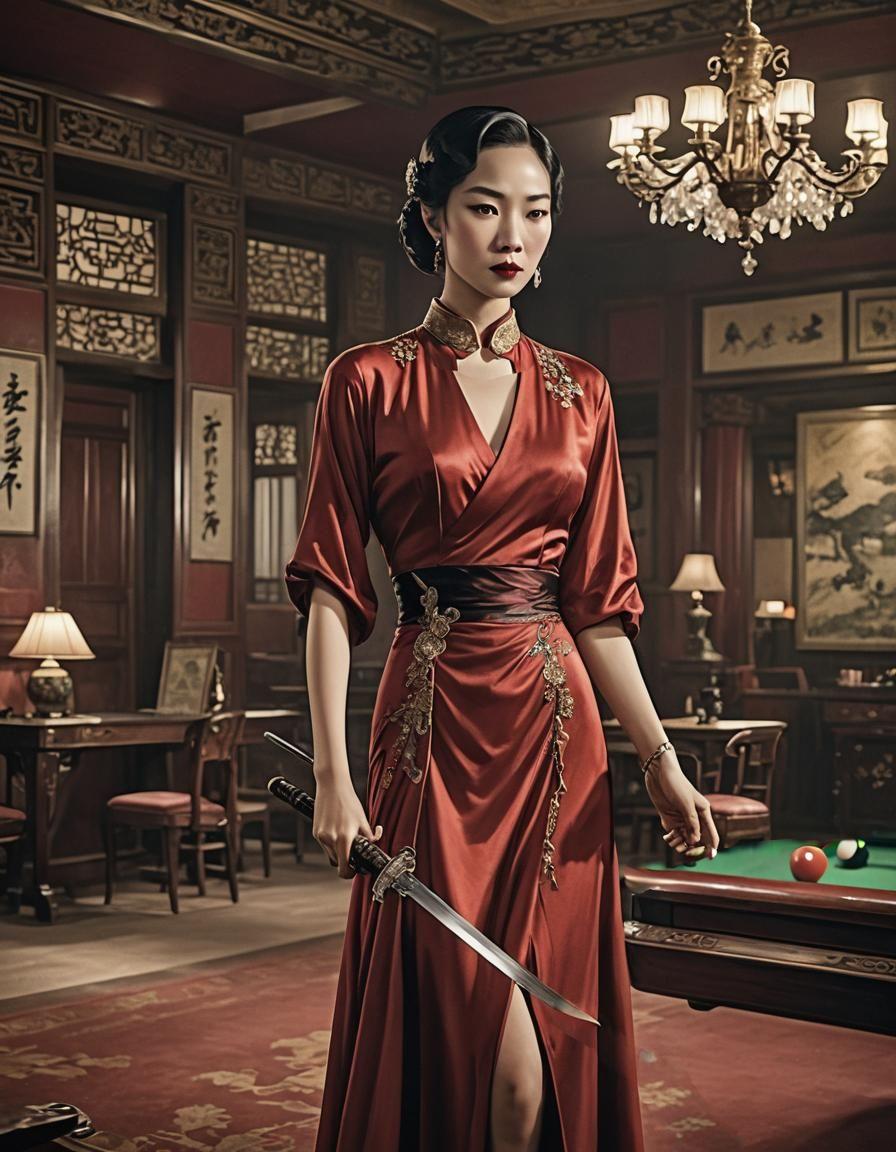







I acknowledge that it's hard to tell what weapon some of the characters are holding (or associated with in the picture) or what room they're in, so that'll need a bit of work. But this is a good start.
I like these two 3D designs. You could do a similar one for the Señora.
You could have mentionned that these pieces behave as the opposite of the so-called Chinese pieces, xiangqi's Cannon (a.k.a. Pao), Vao and Leo.
The names Faro, Loco, Señora are smart. A semaphor (Faro) is a kind of tower (Rook is Torre/Tour in Spanish/French), Loco is the Spanish translation of Fou in French which is the name for the Bishop in chess, and obviously Señora, lady in English is related to Dama/Dame in Spanish/French, meaning lady in English and the name of the Queen in chess.
Good post.
Maybe he saved Señora & Señor for next week.
I actually do have the Señora (and Saltador) on my Thingiverse page (though I didn't think to do the Señor; thanks for reminding me about that link, HaruNY!). I'll probably post them all separately at some later date, as a follow-up.
As to the contrast with Chinese pieces, I would have done that but I couldn't remember which pieces the Argentinian ones contrasted with.
PS: I like my interpretation of Loco better. But then again, I would. :þ :)
279. Striped Dragon. I was trying a couple of months ago to figure out a good counterpart for the Tiger, but all anyone could offer as a name was Dragon, which I'm reluctant to use because there are so many Dragons running around the site (I even have some work done on a variant featuring every one I could find). So, I waited until something presented itself; and finally, a few days ago, it occurred to me that if it's related to the Tiger, maybe this Dragon is striped. So, while it's generally known as just Dragon, I decided to call it Striped Dragon.
The move is simple: the Striped Dragon makes a (2,3) leap like a Zebra, then may slide from there orthogonally outward like a Rook. ([Z?R])
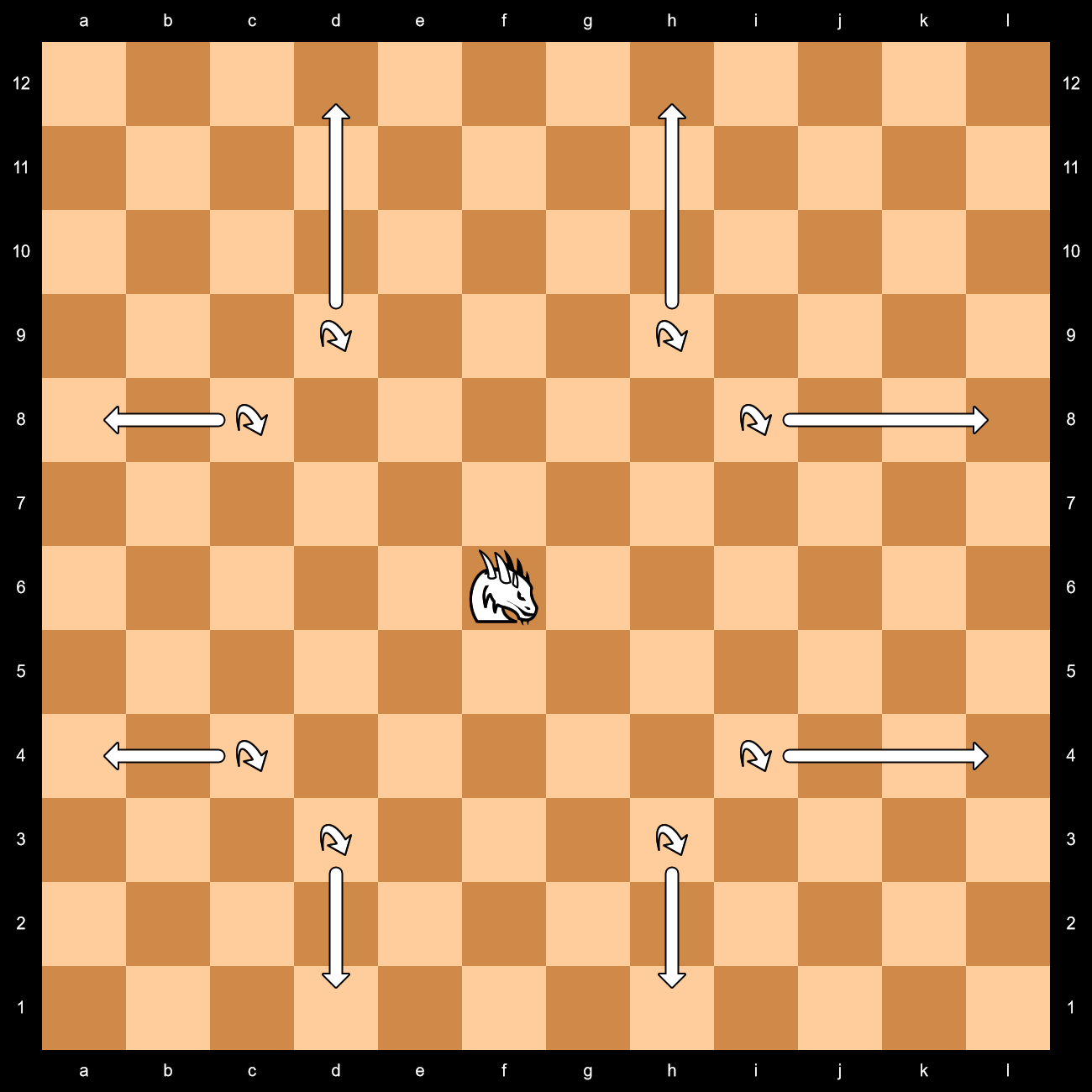
And so now we have a pair.

Despite the lack of wings, I think this piece looks quite draconian.
It reminds me of the sandworm of Dune. Well, if it was a sandworm it would have a larger diameter, which a could be a good idea because in reality I would fear this piece breaks too easily.
A Sandworm might make an interesting piece.
Has anyone besides me even used this piece? It seems strange to say it's generally known as anything. A less overused alternative could be Salamander, although that does seem to be used in Typhoon for KmyadabuQ4. Striped Dragon sounds like a decent solution.
Has anyone besides me even used this piece?
Now that I have a name for it, I intend to. In fact, I've already added it to the piece list for my all-Dragon game.
@Bob: Yes. I imagine a piece that can land on a friendly piece and immediatly kills (removes) that piece and all pieces in the 8 squares around, friend or enemy.
It is possible to capture an enemy sandworm. It is possible to move to an adjacent square to a sandworm, friend or enemy. The sandworm capture adjacent pieces only when it moves.
That's one take, though the larger sandworm like that is one that I'd want to represent with a giant piece (one that takes up more than one square), something that isn't implemented in XBetza, and probably -- probably -- never will be. In any event, removing adjacent pieces upon capture of a central one will probably have to wait until HG can program in the semicolons for bracket notation.
I have something a little different in mind for something more man-sized. I'm not sure yet whether it'll be today's PotD, or tomorrow's...
280. Yak. No, this isn't another Tifinagh piece*; this is named for the animal.
It simply occurred to me recently that particularly large boards could use a piece that's the equivalent of a Buffalo (NCZ), extending one space further. I considered naming it for a pouncing predator, but besides most such creatures being already taken, it didn't seem to fit the established pattern. This piece combines the leaps of the Knight (horse), Camel, Zebra, Giraffe, and Antelope, and also includes many compound ungulates (Gnu, Bison, Okapi, Buffalo, and so forth), so an ungulate seemed fitting. After a little bit of research, the animal that stood out was the Yak. (NCZFXNY)
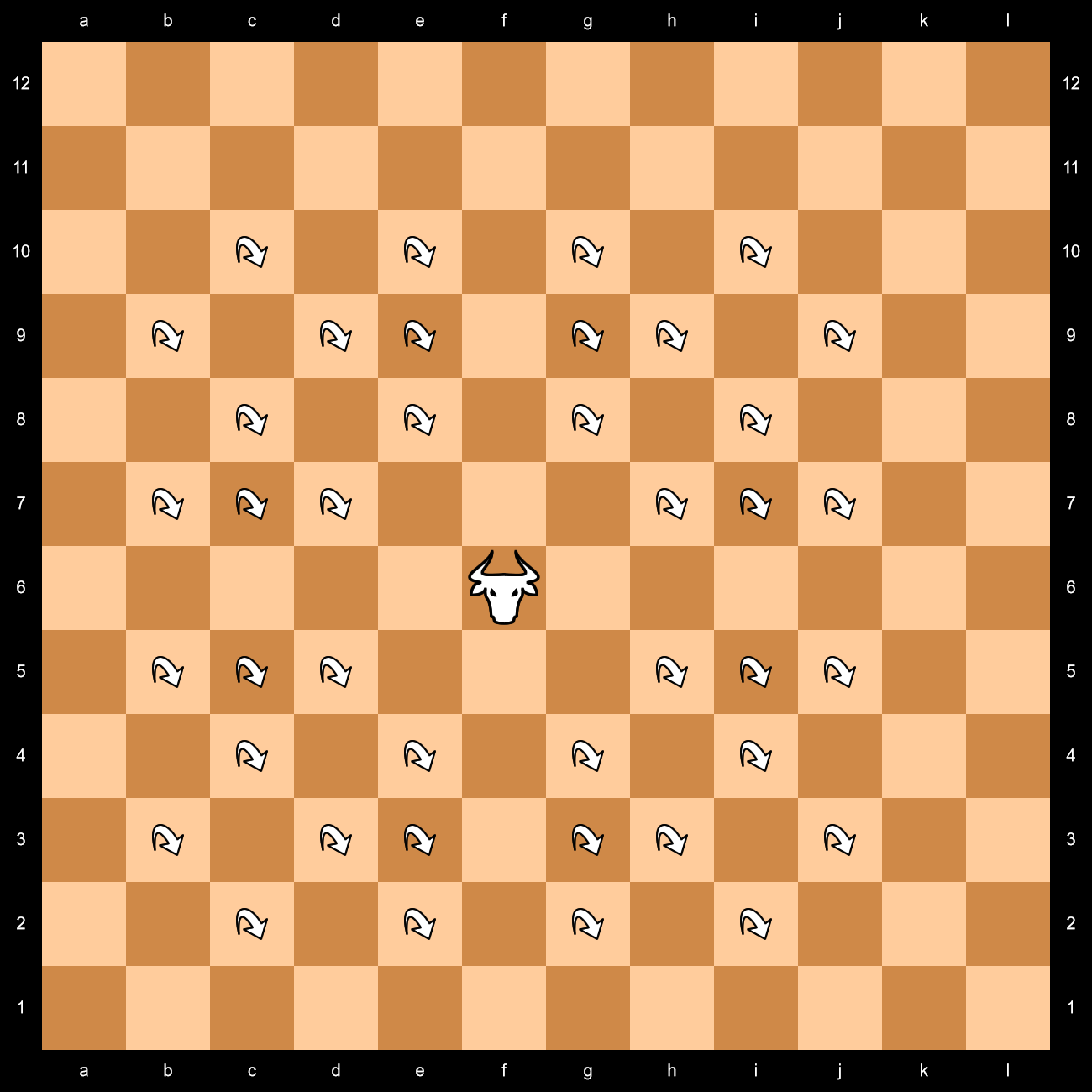
I deliberately excluded the (4,2) leap of the Hare/Stag/Lancer since it's just an extension of the Knight move; pieces that add the DY or N2 can be considered separately. As it is already, it can be a formidable and versatile piece.

*The two forms of the letter yak are ⴽ and (in Tuareg) ⴾ, neither of which (in my opinion) make particularly good chess pieces -- at least, not without some sort of mirror image.
Demiurge Turtle is mScK4 since it's based on Mock Turtle from Jupiter.
Thanks for the catch. I only just recently realized my error there. I'll go fix that, both here and in my games where it appears, today and tomorrow.
281. Mei (Chinese Rose / Rao). If a Nao is a Chinese Nightrider, then could there be a Chinese Rose? Well, of course there could! Like the Nao, the Mei (the best translation into Chinese for the word "rose" that I could find*) moves without capture normally, but must jump over a hurdle to capture. It's just that the Mei moves like a Rose. (mqNcqpN)
I don't think a move diagram is needed in this case, since most of us here knows how the Rose moves. I can vouch that the above XBetza does work; I tried it out in the XBetza Sandbox, and it behaves just as intended.
As I was informed in a later reply, this piece is called a Rao by chess problemists.

Creating this led me to discover some serious design flaws with my original Rose piece, which I've now corrected on my own system and will upload some time soon (Thingiverse is still having problems.)
*I have no doubt -- and, in fact, much hope -- that someone well-versed in the language will correct me if I got it wrong.
The issues that the Tinkercad website is having recently may lead me to take a break after this weekend. Since the problem mainly affects new uploads, I may continue for a short while, but otherwise I'll just wait for the problem to be fixed.
I had already planned on only going to #366 (I'm running out of possible pieces to post), posting only occasionally afterward for extensions of sets, missed rotary counterparts, special requests, new discoveries, and so forth. I also had planned, if I hadn't done this already by then, to take the time to create an index of sorts that I could post as an article.
25 comments displayed
Permalink to the exact comments currently displayed.
275. Yey. This is another piece that I built based on a letter of the Tifinagh, and it's one that I'm a little surprised I haven't alraedy posted.
Based on the Berber letter ⴻ, Yey moves one space sideways, or leaps two spaces vertically. If the latter move captures a piece, it may then move without capture from there to any adjacent space. (sW[vD?a(b)K])
I think that this would be an interesting piece to use as a special Pawn, promoted Pawn, or "superpawn."